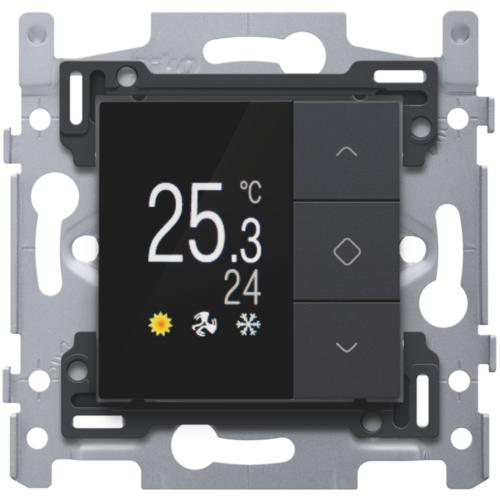HVAC thermostat Niko Home Control
No longer available since June 2024
Description
You install the HVAC thermostat in any room that has an indoor unit of the VRV, VRF or multi-split air conditioning system (HVAC system). The HVAC thermostat controls the heating or cooling of the room in which it is installed. You can modify the temperature and adjust the ventilation speed. As Niko Home Control controls the heating or cooling in different rooms, the resident can considerably save energy by linking the HVAC thermostat, for example, to the eco-function (all off) or calendar-based functions. The resident will use the PROTECT mode for long-term absences: the room temperature will be maintained between a minimum and maximum value. The HVAC thermostat works together with the Niko Home Control IP interface and gateway. The communication with the HVAC system is established via the HVAC interface (CoolMaster).
This article is protected by at least one patent (application). For more info on patents, see www.niko.eu/innovation.
Specification description
HVAC thermostat Niko Home Control.
- Function: The HVAC thermostat allows you to control the air conditioning system (HVAC system) within a zone or room. The HVAC thermostat and the air conditioning system communicate via an HVAC interface (CoolMaster). The HVAC thermostat can be operated locally or remotely via a touchscreen, smartphone or tablet. Each HVAC thermostat can be programmed independently. There are three adjustable temperature settings (DAY, NIGHT and CUSTOM) and two weekly programmes to choose from. You can use the pre-programmed settings or enter your personal settings. Each temperature setting has two values depending on the operating mode that has been activated (COOLING or HEATING). In addition, there are three status options (ECO, PROTECT and ON/OFF) as well as the option to enter the temperature of your choice. Statuses ECO and PROTECT cannot be selected via the HVAC thermostat. Using the HVAC thermostat function, you can:
- select one of the temperature settings or pre-programmed weekly programmes.
- modify temperature settings.
- modify weekly programmes.
- modify the temperature setting for a certain length of time.
- set the date and time.
- change the ventilation speed.
- Change the operating mode (cooling or heating).
- switch off all indoor units within the zone.
An HVAC thermostat can be mounted in any room fitted with indoor units of the HVAC system. It controls the heating or cooling for the room in which it is mounted. The HVAC thermostat only functions properly when the temperature within the room can be measured accurately. Try to eliminate as many factors as you can that may inhibit the thermostat’s ability to accurately control the room temperature.
DO NOT mount the HVAC thermostat:
- in direct sunlight.
- on an exterior wall.
- within the immediate vicinity of a heat generating source (heater, radiator, etc.) or electrical equipment that may radiate heat (TV, computer, etc.).
- behind a curtain.
- Compatible with the Niko Home Control solar mode
Do not allow air to circulate behind the HVAC thermostat. If needed, fill in any gaps in the flush-mounting box or bus cable duct using PU foam. Push buttons with display are integrated in a bridge. The thermostat conforms to IEC60730-2-9, EN 50491-5-2, EN 50491-2 and EN 50090-2-3
- Screen type: lit colour display with the dimensions 45 x 45 x 32 (HxWxD)
- Input voltage: 26 Vdc (SELV, safety extra-low voltage)
- Flush-mounting frame
- 1 mm-thick metal
- galvanized on all sides after cutting, even on the cut edges
- with 4 grooves with screw hole of 7 mm
- with 4 screw holes (indicated by a screw symbol) with a diameter of 3 mm for mounting on panels
- Fixing method
- with screws for simple fixing in a flush-mounting box with grip surfaces
- Centre-to-centre distance
- horizontal coupling and vertical coupling with centre-to-centre distance 71 mm
- horizontal connection of several bases is quick and perfect thanks to the folded-up dovetails on the left and right side
- extra robustness due to the folded-up edges on the outside of the base and the continuation to the inside of the base
- End border: The flush-mounting frame is equipped, both on the top and the bottom, with a dark grey, plastic end border. This border is made of PC+ASA and is joined to the flush-mounting frame using a melting process. The corners of the two end borders are equipped with rectangular openings (7.9 x 1.5 mm) each containing a multi-positional snap hook. Thanks to the snap hooks, the 4 rectangular openings ensure that the faceplate can always be attached flat to the wall, even in cases of untidy plasterwork. This works in two directions: If the flush-mounting box sticks out of the plasterwork, the multi-positional snap hooks can compensate for a 1 to 1.2 mm margin; if the flush-mounting box is sunk too deeply in the plasterwork, the snap hooks can compensate for up to a 1.8 mm margin. The end borders also have 4 round openings that ensure the correct positioning of the faceplate in relation to the central plate.
- Dimensions (HxWxD): 73 x 73 mm
- Marking: CE
Select a product below to view related articles, variants or accessories:


